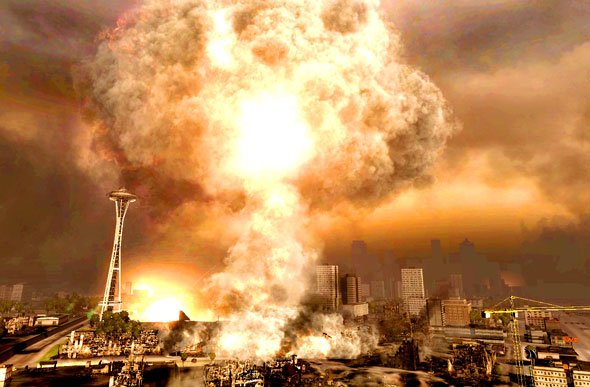As part of our ongoing celebration of all things StarCraft, we're hosting a Starcraft smörgåsbord, with a different theme for each of the days leading up to and the week following SC2's release. This article is a part of the "Everything We Know About StarCraft Day", the first of the bunch, and is an online release of Dan Stapleton's musings on superweapons, including SC2's nuke, from the October 2008 issue's Strategy column.
StarCraft II: WMD-Related Program Activities
Sometimes, superweapons just aren't super enough
It has long been my belief that building a superweapon should make you feel like a power-crazed madman (kind of like Kim Jung-Il, except better looking) and grant you an awesome destructive capability more than potent enough to compensate for any shortcomings you may have been teased about in the high school locker room. I'm talking about superweapons like the nukes we get in Supreme Commander, which can easily obliterate an entire base and everything in it, save Indiana Jones hiding in a refrigerator.
But most games don't trust us with that kind of firepower, and instead give us weaksauce superweapons—in fact, I'd go so far as to demote them from “super” to “pretty good.” In games like Command & Conquer 3, the nuke and ion cannon are effective at taking out units, but roughly equivalent to a stiff breeze when it comes to knocking down major buildings. Sins of a Solar Empire's weapons, like the novalith cannon, can't hold a candle to the Death Star. The design philosophy here is to make superweapons a means to an end, rather than the end itself—launching a superweapon strike on an enemy base to soften up defenses ahead of a conventional invasion can turn the odds in your favor without making the battle too one-sided, and since people want to see huge explosions every six minutes, what's the point of having a cool superweapon you only get to use once per game?
I respectfully disagree with that philosophy. Hearing nuclear missile launch warnings should make you void your bowels, not sigh, “Again?” and get ready to rebuild minor structures. I'm more a fan of Chris Taylor's technique: give players ridiculously powerful weapons as well as the tools to stop them. Nothing is more satisfying than successfully shooting down an incoming nuke and imagining your enemy yelling, “Nooooo! Thwarted again!” and then redoubling his efforts to destroy you. Nothing, that is, until you take out his anti-nuke launcher with a well-placed strategic bomber run and land a nuke of your own dead-center in his base. And really, how better to end a game than with a blaze of glory and a mushroom cloud?

I'm encouraged to see that StarCraft II's superweapons seem to lean more toward this kind of powerful-but-counterable design. According to some early numbers, the Terran's nuke power has been increased by around 60 percent, making it much more lethal than in the original (and you can stop it by detecting and killing the ghost spotter), and the Protoss Mothership is a potential base-killer if it gets close enough, but can be taken down without too much effort. In both cases, you'll have to make key strikes to destroy stealth detectors or anti-air defenses ahead of your superweapon attacks, rather than simply lobbing nukes in to destroy defenses. A well-defended base isn't easy to build, and shouldn't be so easily cracked.
That said, there's plenty of room in the RTS genre for both types of superweapons. In fact, when it comes to weapons of mass destruction, I find it's often a case of the more the merrier.
The biggest gaming news, reviews and hardware deals
Keep up to date with the most important stories and the best deals, as picked by the PC Gamer team.
Five games I'm playing: S.T.A.L.K.E.R.; Space Siege; Sid Meier's Colonization (1994); Supreme Commander: Forged Alliance; Sins of a Solar Empire
PC Gamer is the global authority on PC games—starting in 1993 with the magazine, and then in 2010 with this website you're currently reading. We have writers across the US, Canada, UK and Australia, who you can read about here.


